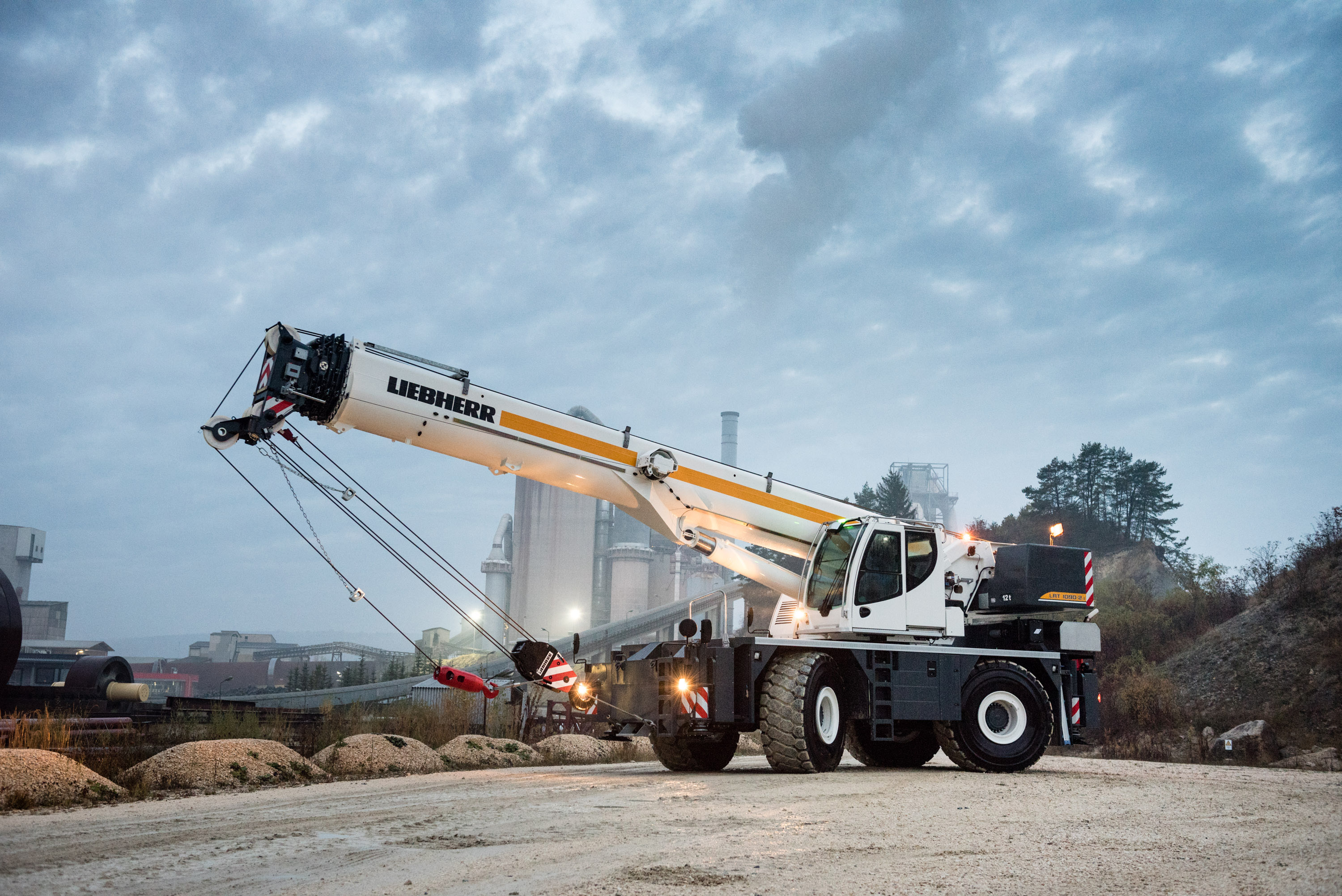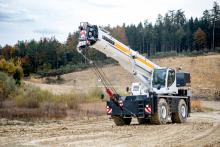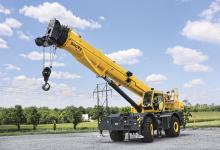
The LRT 1090-2.1 and LRT 1100-2.1 feature high performance, safety and comfort, according to the manufacturer which had the series in its range in the 1980s to the mid-90s – rough-terrain cranes with a lifting capacity of 25-80tonnes with the Liebherr designation LTL.
The two newly designed LRT cranes are based on the same basic technical concept. The crane chassis and turntable are almost identical. The differences relate to the boom length, telescoping technology, ballast weight and lifting capacity.
Liebherr says that high safety levels in were the main priority for the design. Both new models feature an outrigger monitoring system as standard. The support status, on tyres or outriggers, is detected automatically and saved to the crane controller. The attachment of the ballast to the turntable and the installation of the optional double folding jib including its angle adjustment are also recorded and monitored.
Liebherr’s VarioBase variable support base allows each outrigger beam to be extended to arbitrary lengths. The crane work is controlled by the load moment limiter within the LICCON controller which calculates the maximum load capacities precisely for the situation. Liebherr says that this prevents accidents by human error during the assembly process and when hoisting loads.
VarioBase® also provides greater flexibility on site. As a result of the increased lifting capacities when hoisting over the supports, the crane can hoist loads normally reserved for the next higher crane class.
Safety is also enhanced by providing greater comfort for the crane operator. For example, the crane cabin is 220mm (8.5inch) wider than other standard cabins on the market. It can be tilted backwards to provide greater comfort when hoisting loads to great heights. A cooler and USB charging socket are standard features in the cabin.
There are ladders, a large number of handles and an electrically extending platform on the cabin to ensure safe access to the crane. The new LRT cranes feature a wide range of storage boxes for accessories, rigging equipment and support timber as standard. They also have a storage facility for the crane hook.
Liebherrs says that its two newly developed LRT cranes are the first mobile cranes to meet global safety standards and comply with all global regulations such as the US standard ANSI B30.5, European EN 13000, Australian Standards (AS) and the Russian GOST standard.
Both crane models are powered by a Cummins diesel engine developing 194kW and supplies a maximum torque of 990Nm. A six-speed powershift transmission from DANA and large 29.5 R25 tyres guarantee the required off-road capability for the cranes. Their maximum speed is 25km/h. All-wheel and crab steering ensure easy handling and high manoeuvrability in constricted conditions.
The LRT cranes measure 3.87m in height and 3.3m wide and are transported on public roads with a low loader. Their curb weight is less than 55tonnes with complete equipment including ballast or under 40tonnes without ballast and without equipment. That means that the new rough-terrain cranes from Liebherr can be transported worldwide at low cost.
The 100tonne LRT 1100-2.1 has a 50m telescopic boom with a "Telematik" telescoping system on which the various telescoping sections can be extended independently with a single cylinder and then pinned to the telescopic section above. There are two telescoping modes, Strong and Long. Up to 14tonnes of counterweight ensure high stability.
The lifting capacity of the LRT 1100-2.1 is around 15% higher than that of the 90tonne (100ton model which features 12tonnes of counterweight. The LRT 1090-2.1 features a 47m telescopic boom. Its telescoping system consists of a two-stage hydraulic cylinder with a rope extension mechanism. Like the 100tonne model the boom can be extended easily with two telescoping modes, Strong or Long. The extension mechanism on both crane models has been designed for high telescoping lifting capacities.
A second winch and the rooster sheave are included as standard on the basic machine for two-hook operation. As an option a 10.5-19m double-folding jib can be installed on the telescopic boom. It can be attached at an angle of 0°, 20° or 40°.








